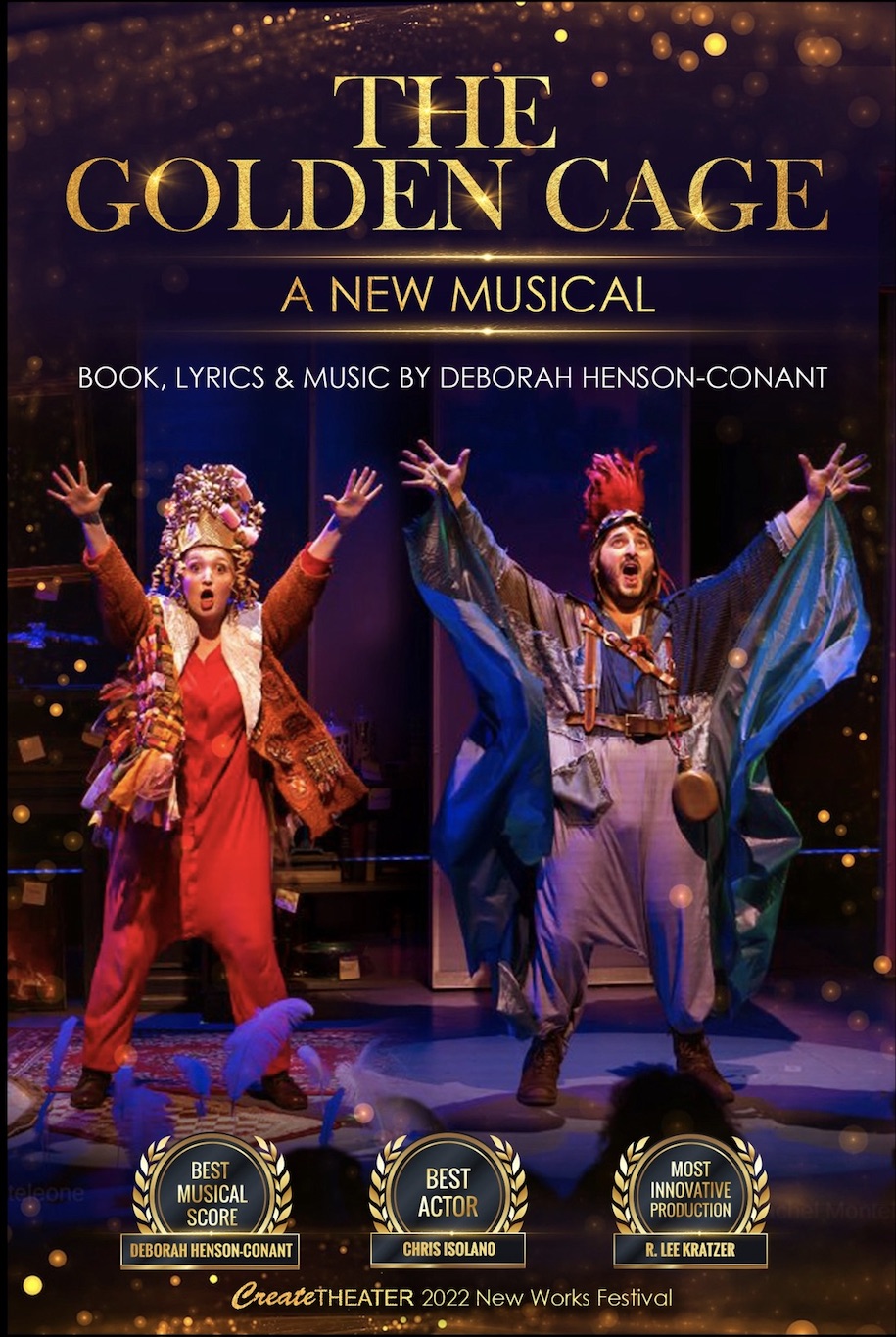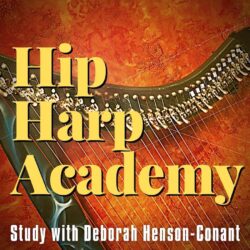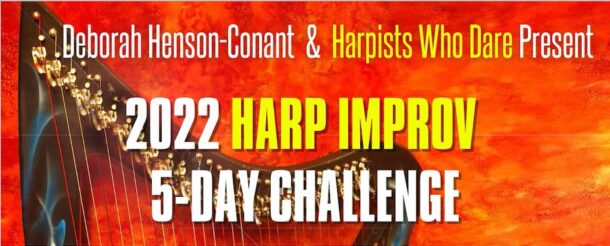Are YOU a Harp-Breaker??
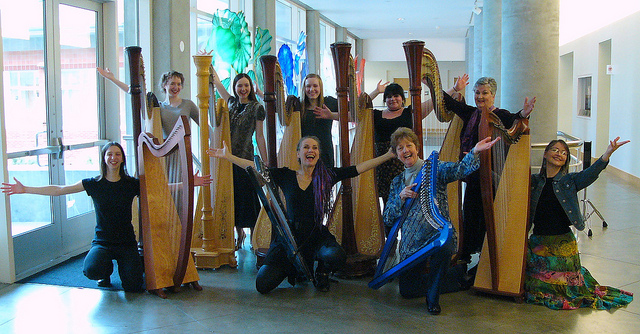
You could be!
At selected shows I invite local harpists to join me on stage for a “Harp-Breaker Experience”!The “HarpBreakers” are an ensemble of harp players – of all ages, sizes, playing-levels, and harp-types, joined for a joyous. semi-spontaneous suite of pieces – played with me on stage at the concert. Yes – YOU and your harp are right on stage with me.
And the audience LOVES YOU!
HarpBreakers have joined me for solo shows, symphony shows and chamber ensemble shows. Each time we put together a new group, named for the location or the sponsors of the show, like “The Houston HarpBreakers” or the “The Nike HarpBreakers.”
What makes a “Harp-Breakers Experience” work so well is that all the pieces are SIMPLE and powerful. You play at your level, I support the group from the electric harp — and it’s all about the ensemble experience – and the joy it creates for you … and the audience.
Learning the pieces with the video tutorials and playalong files is itself a fun experience, rehearsing them is an opportunity to develop your ensemble skills – and the pieces are all part of my “Instant Ensemble” program and my “World Harp Ensemble” Project. They include a Blues, a Calypso, and a piece that combines playing and singing in a way that’s so organic that everyone sings – including the audience.
Best of all – you’re not doing it alone! If all you can play is one note – you’re playing it with aplomb, and it’s an essential part of the ensemble! If you are a seasoned professional, you’ll have a chance to shine. And for the audience it’s magical: fun, energetic, full of spirit, beauty and the power of community.
Who is invited to be a Harp-Breaker?
 Anyone is invited so long as you play the harp, you’re willing to learn the music by heart, attend the rehearsal(s), play with panache and bring your friends and family to enjoy you in the show!
Anyone is invited so long as you play the harp, you’re willing to learn the music by heart, attend the rehearsal(s), play with panache and bring your friends and family to enjoy you in the show!
In some performances we’ve gone for the Wow-Factor by involving as many harpists as were logistically possible (i.e. the maximum who could fit on stage) — and the Cute-Factor by involving young student harpists as well as professionals — and we always commit to the “Solid Music” and “Fun” factors.
TEACHERS often work with their students on the pieces, and then they can be involved as a group with the concert (meaning, the teachers and their students will often play near each other on the stage).
What’s most important is that each person play at their own level. It’s absolutely essential that you’re realistic about your technical level. You can simplify the music as much as you need to – that’s easy to do – you just must be willing to play at the level of simplicity that allows you to focus on listening and really playing with the rest of the group. If you’re not sure how to do that, you’ll be able to ask me.
The important thing is your commitment to “playing with the ensemble” … and not to “getting all the notes.”
Are Non-Harpists Invited?
Yes – we’ve had non-harpists in the group, including harmonica and ukulele players. If you don’t play the harp, let me know what you play. You’ll need to commit to learning the music, and be flexible in developing your part during the rehearsal and you must bring a professional-musician mentor or buddy with you (if you’re not a professional yourself) to help you navigate the music.
What does it cost? (Hint: It’s FREE for you!)
The HarpBreakers is all about music, fun, learning, community-building and audience-building. The experience is totally free for every harp-breaker on the stage – and it’s a chance for you to invite your friends and family to buy tickets to see you perform in a show they’ll love.
How did this all start? Who were the original Harpbreakers?
I took the name from an album by the extraordinary Scottish harp duo Sileas (Patsy Seddon & Mary McMaster), and they were the first harp duo I’d ever seen who joined their harps and their voices, and so mesmerized an audience with the beauty, energy and rhythmic joy of their playing that it forever changed my experience of the word “Harp Ensemble”
Now, when I create this roving ensemble, I call it “The Harp-Breakers” or, using the name of the town, sponsor, state or region we’re in we call the group “The LocalName Harp-Breakers” like, the Boston Harp-Breakers or “The Nike HarpBreakers.”
About the Music
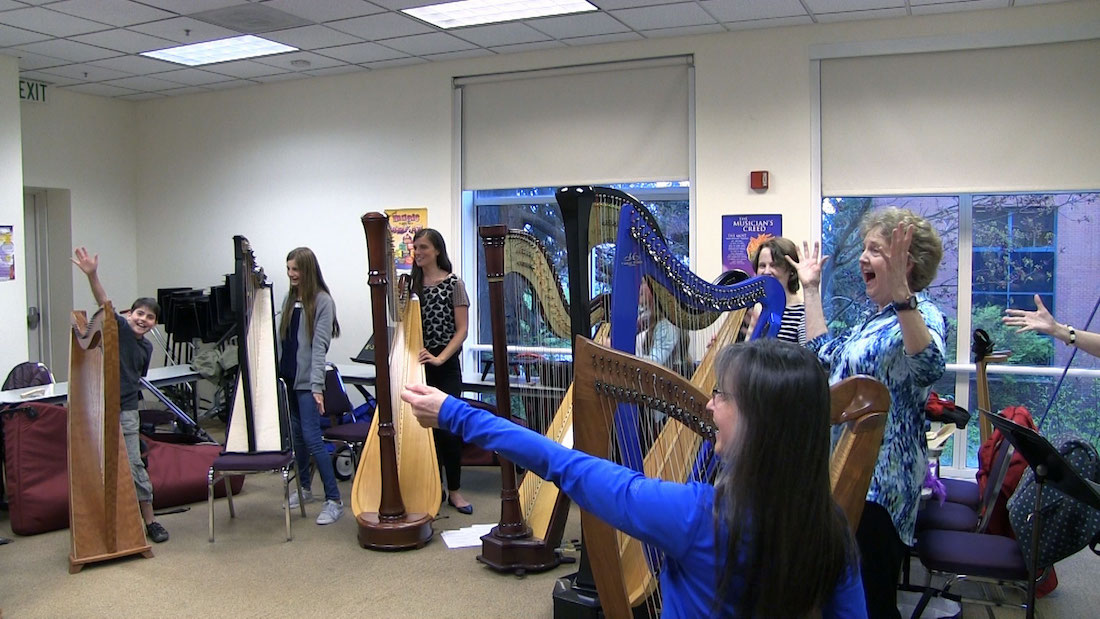
How Many Pieces will we play?
We currently have 4 tunes available – though we usually only play between 1-3. They’re all easy to learn and there are play-along files and videos to help you learn them. Fill this out to get access to the pieces.
- NEW BLUES: If you’ve heard or played my piece “New Blues” – this is an adaptation of that piece that’s easy to learn and fun to play together
- CALIFYPSO: This piece is almost like a game that shows off the orchestra (when playing with symphony) or guest artists in solo shows. It also includes percussion play-alongs in the audience, and a chance to learn the strumming techniques I use in many of my Flamenco-inspired pieces.
- YOU HAVE A VOICE: This simple, powerful piece combines singing & playing – including harmony that the audience sings. If you’ve never done sung and played together, you’ll be surprised how simple it is with this song. No words to memorize, no fancy coordination – it’s all about listening and joining the simple beauty of the song.
- LOVE GONE BAD: This is a Blues that’s based completely on a Blues Scale. That means you set your lever or pedals and voilá – you’re playing the Blues!
About Learning, Rehearsing & Performing
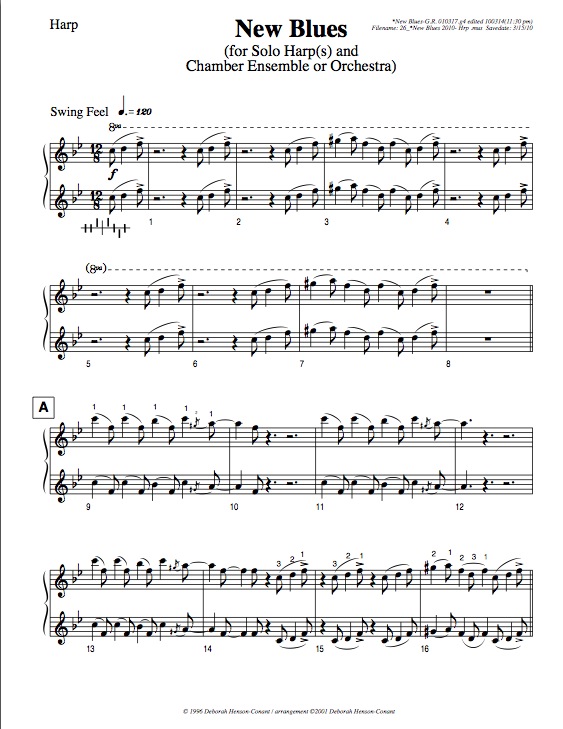 About Learning & Playing the Music:
About Learning & Playing the Music:
(note: Don’t try to print the music at the left. It’s just an example so you can see the level of simplicity. Don’t worry about the rhythm – you’ll learn that from the playalong files – and note that you can simplify it and play just one line).
- The music can be played on Eb lever harp of any size – or pedal harp, and every piece can be played by a variety of skill levels (i.e. it’s easily simplifiable).
- The trick in learning it is to learn what you can play well – even if it’s not every single note, memorize that, and play it strong and in time with the music. Have fun, and get comfortable so you can move around to the rhythm of the music, and so you’ll be able to connect with me (DHC). That’s the goal of this ensemble!
- You must memorize the music: This music is quite easy and there’s lots of repetition. There are MP3 playalong files, so you’ll have plenty of opportunity to get comfortable with the music. It’s essential that you memorize it so that you can respond to me, to each other and to the ensemble on stage.
- No stands – no stools! We will play the pieces without stands and without stools! That means you’ll be standing when you play. If you harp is very small, then you should plan to either wear it with a strap, or kneel on the floor, because the rule is: just you, the instrument and a tuning key.
- Harp Helper: You must have a designated harp helper with you at all times during rehearsal and concert. Sometimes these are called “Harp Dads,” “Harp Moms” or “Harp Hunks” – they can be any age or gender so long as they’re calm, strong, punctual and able to help you get your harp where it needs to go.
- You must commit to being Punctual for the Rehearsal(s) You must commit to being punctual for rehearsal(s), loaded in, tuned and ready to play. Sometimes we have only a single rehearsal the day of the show – and every rehearsal is essential (and so much fun you won’t want it to end)!
- Costuming: You can wear whatever you want, so long as it doesn’t conflict with symphony or ensemble rules. It’s most fun if everyone dresses up as they would if they were a soloist – the way you feel most fun. The way you want others to see you. The way you secretly want to see yourself.
- When does it happen in the program? The piece(s) are usually programmed right after intermission, so we can place the harps on stage during intermission.
- We need at least ONE Designated Harp Diva: Because I will rarely be able to rehearse with you in advance, each ensemble needs at least one “Designated Harp Diva” who will rehearse the ensemble (if there’s time) and be the ensemble leader. This can be someone of any gender or age, but it should be someone used to leading and conducting ensembles. If that’s you, or if you’re a teacher with students you’ll be bringing to play with you, please let me know!
- Great for teachers & students! This is a great opportunity for students and their teachers to take part in together, with teachers helping their students simplify and solidify their playing for a powerful ensemble experience – and then playing along-side each other in the ensemble.
- Amplification? The Harp-Breaker harps are rarely amplified unless there’s an advanced player who’ll be taking a solo – and even then we avoid that. The goal is to keep technical issues to a minimum so we can get on and off the stage quickly – and the advantage is, you don’t have to worry about amplified bloopers so you can really just have FUN in the ensemble.
About the Rehearsal(s)

- Harps-Alone Rehearsals: Sometimes I’m not able to rehearse with you at all, sometimes we can only rehearse once, a few hours before the show — and sometimes I’ll will try to arrange online rehearsals. That may mean you will need to learn how to use an online resource like Zoom. If I’m able to rehearse with you in person, it’s likely it will be shortly before the orchestra rehearsal and/or soundcheck, in a large practice studio or on stage – and we probably won’t have a lot of time, so you need to be prepared and ready to play.
- If we’re playing with Orchestra or Chamber Ensemble: When we play with chamber ensemles or symphonies, we usually rehearse these pieces right after the first orchestra break so we can use the break to position the harp ensemble for rehearsal. The time with orchestra is VERY, VERY limited. You will need to be ready to play, and it’s likely we may get to go through the piece only once. You’ll probably have to either leave the harps on stage at that point, and remove them after the rehearsal, or you may have to remove them quickly from the stage. That will be determined by the orchestra management.
About Publicity & Inviting Audience Members
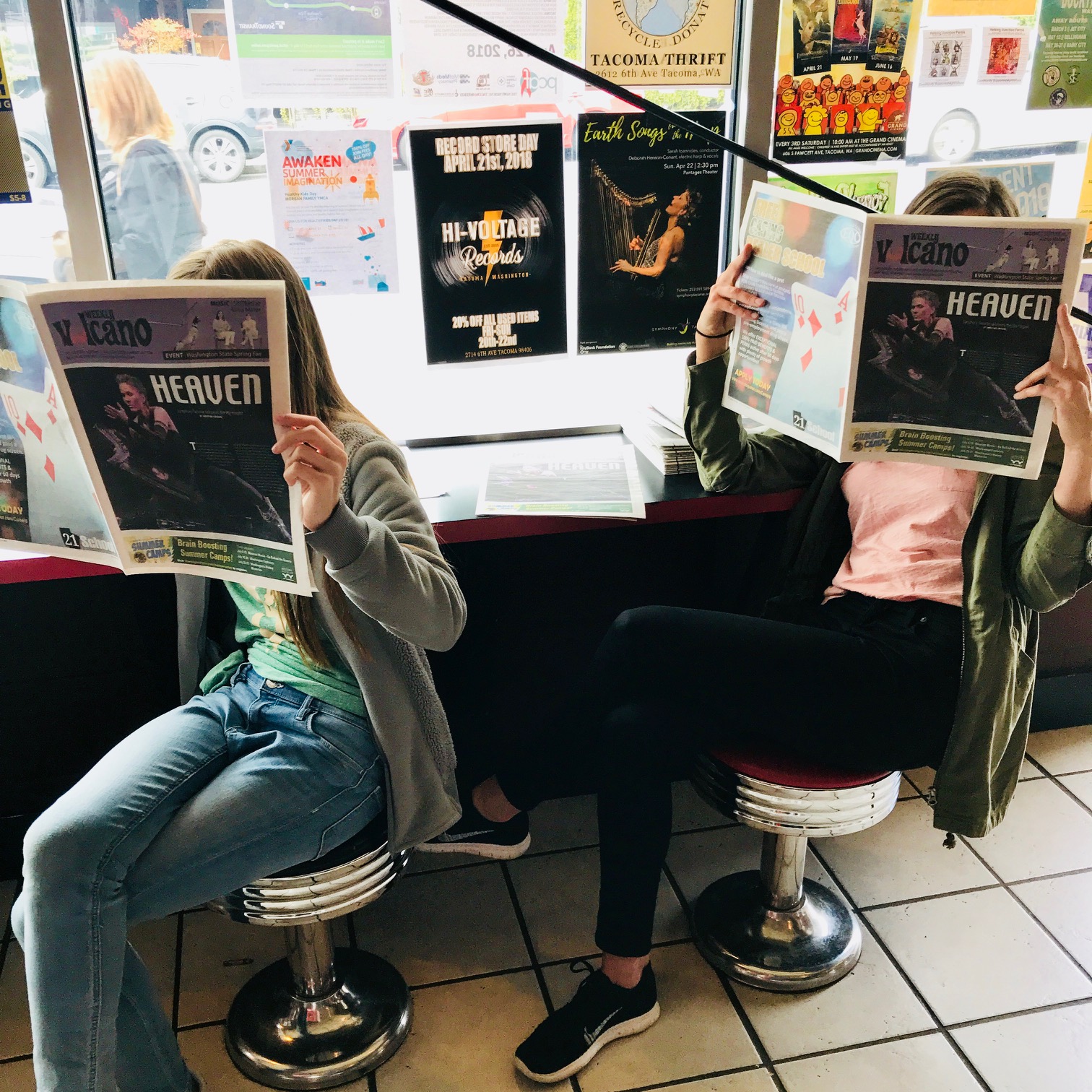
Sometimes the “Harpbreakers” are an exciting last-minute addition to a show – sometimes there are months of preparation. Regardless of how soon the show is, tell all your friends that you just got invited to play on stage with a Grammy-Nominated performer – and invite them to come and enjoy the show and cheer you on! Use social media, phone calls, tell everyone you know so they can come, and take photos, and you can talk about it afterwards (many people talk about it for years afterwards!)
TIP: Use social media, phone calls, tell everyone you know so they can cheer you on – and enjoy the show!
If you have a month or more to prepare, you can let your local paper to let them know you’ll be performing. Ideally this all starts 6-8 weeks in advance – but sometimes it’s even more effective when you do it in the last week or two before the show. The best thing to do is to write a press release, and email it to your local music reviewers and editors of your local paper with a publicity photo of you, as well as telling friends and posting on social media.
Here’s an example of a press release you could send to your paper:
FOR IMMEDIATE RELEASE. Run through (INSERT DATE OF CONCERT)
CONTACT (INSERT YOUR NAME, EMAIL & PHONE)
(INSERT NAME OF TOWN) Resident to perform with GRAMMY® Nominated Electric Harpist and (INSERT NAME OF SYMPHONY)
(INSERT TOWN)’s own (INSERT PLAYER) has been specially invited to perform harp with GRAMMY®-nominated composer and recording artist Deborah Henson-Conant and the (INSERT SYMPHONY NAME) on (INSERT DAY & DATE), at (INSERT TIME) at the (INSERT THEATER-NAME) in (INSERT CITY). Tickets are available (INSERT TICKET INFO). Prices are (INSERT PRICES).
(INSERT PLAYER) joins Henson-Conant and (INSERT QUANTITY OF PLAYERS) other local harpists in a unique ensemble called “The Harp-Breakers,” during Henson-Conant’s alternate-symphonic program with the (SYMPHONY NAME) featuring electric harp, voice and orchestra in a fusion of Folk-Flamenco-Latin-and-Blues.
Visiting soloist Henson-Conant is a groundbreaking musician and innovator known for widely diversifying the approach to the harp – “She’s doing for the harp what Chuck Berry and Elvis did for the guitar” says the Denver Post – and inspiring the world’s first commercially-produced carbon-fibre electric harp, named after her, the “DHC Blue Light.” She tours internationally in solo and orchestral concerts, and is known for her music special on PBS, “Invention & Alchemy.”
(SOMETHING ABOUT THE LOCAL HARP COMMUNITY, LIKE THIS: Henson-Conant has long known about the rich harp community in the Puget Sound area, developed by local teachers like Pat Wooster in Tacoma and Susi Hussong in Seattle, so when she was invited to perform with the Tacoma Symphony Orchestra, she immediately inquired about featuring local harpists in one number: her symphonic bebop “New Blues.”) “This opportunity is great for everyone,” says Henson-Conant, “For the harpists, it’s an opportunity to rehearse and perform as symphony soloists — and for the audience, a one-of-a-kind musical experience: bebop with a symphony and 9 harps!”
(NAME OF PLAYER) will be featured in this unique ensemble. (INSERT A FEW BIO NOTES/HIGHLIGHTS ABOUT THE PLAYER HERE)
Visiting artist Deborah Henson-Conant has shared the stage with numerous orchestras and contemporary settings, Ray Charles, Bobby McFerrin, Doc Serverinsen, and Marvin Hamlisch. She has performed with the Boston Pops, appeared on two PBS specials, and played with Aerosmith frontman/American Idol judge Steven Tyler. She is a grant awardee from National Endowment for the Arts and “Meet the Composer”. She has been featured on CBS, NBC, NPR, PBS and in interviews by Scott Simon, Studs Terkel, Charlie Rose, and gossip correspondent comedienne Joan Rivers.
More about the show:
(INSERT A LINK TO THE SHOW INFORMATION ON DHC’S SITE OR THE SYMPHONY SITE)
Photos:
(INSERT A LINK TO A HI-RESOLUTION PHOTO, OR INCLUDE THE PHOTO AS AN ATTACHMENT – BUT NO MORE THAN 5MB)
Photos courtesy of (INSERT PHOTOGRAPHER)
Here’s the kind of article or post they might end up writing. This was actually printed in a newspaper for a performance in 2011 and became that harpist’s first feature in a paper.
Buckley harpist to perform with Grammy-nominated composer
Mar 22 2011
Buckley resident Cassie Reinbolt, a freshman at Pacific Lutheran University in Tacoma, has been invited to perform harp with Grammy-nominated composer and recording artist Deborah Henson-Conant and the Tacoma Symphony Orchestra Saturday. The performance is set for 2:30 p.m. Sunday at the Pantages Theater in Tacoma.
Reinbolt will join Henson-Conant and eight other local harpists in a unique ensemble called “The Harp-Breakers,” during Henson-Conant’s alternate-symphonic program with the TSO featuring electric harp, voice and orchestra in a fusion of folk, flamenco, Latin and blues.
Henson-Conant tours internationally in solo and orchestral concerts, and is known for her music special on PBS, “Invention and Alchemy.”
Reinbolt, a dean’s list student at PLU, is studying for a music degree in harp performance. She performed with the Tacoma Youth Symphony 2009-10 as principal harpist and with the South Sound Strings Harp Ensemble for the past eight years. She studies with Patricia Wooster.

